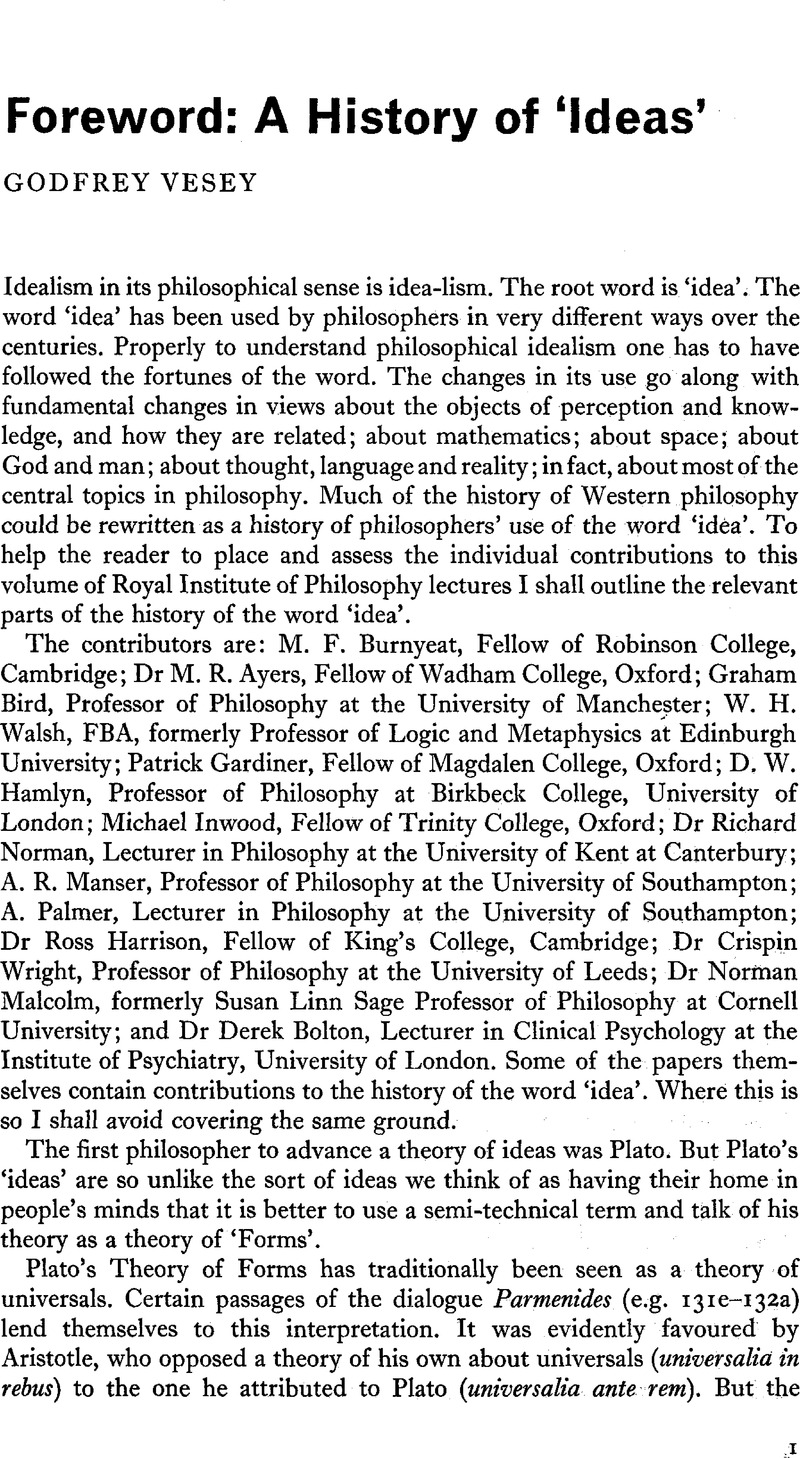No CrossRef data available.
Article contents
A History of ‘Ideas’
Published online by Cambridge University Press: 08 January 2010
Abstract

- Type
- Foreword
- Information
- Royal Institute of Philosophy Supplements , Volume 13: Idealism Past and Present , March 1982 , pp. 1 - 18
- Copyright
- Copyright © The Royal Institute of Philosophy and the contributors 1982
References
1 It would be a mistake to regard this as an irrevocable rejection of teleological explanation. It is arguable that by relating all Forms to the Form of the Good Plato reinstates teleology at the fountain head of his theory. See Taylor, C. C. W., ‘Forms as Causes in the Phaedo’, Mind 78 (1969), 52–54.Google Scholar
2 Descartes' Conversation with Burman, trans. John, (Nottingham (Oxford University Press, 1976), 19.Google Scholar
3 HR = The Philosophical Works of Descartes, trans. Haldane, Elizabeth S. and Ross, G. R. T. (Cambridge University Press, 1931)Google Scholar. The reference is to Volume I, 255–260.
4 This is the summary of the argument given by Maciver, A. M. (‘Is there mind-body interaction?’, Proc. Arist. Soc. XXXVI (1935–1936), 101)Google Scholar, and described by him as a simple fallacy. Descartes's actual argument involves the additional notion that if I am able to apprehend two things as distinct they must really be distinct, ‘since they may be made to exist in separation at least by the omnipotence of God’ (HR, I, 190).Google Scholar
5 Not all the seventeenth-century philosophers who succeeded Descartes agreed with him about people perceiving things by virtue of their minds being causally affected by them. One of the more interesting exceptions was Antoine Arnauld. Part of his Treatise on True and False Ideas (1683) is a detailed refutation of Nicolas Malebranche's Cartesian theory of perception. Arnauld argued against Malebranche that ‘objective presence’ to a mind does not require ‘local presence’; and that for something to be objectively present to a mind is not the same thing as for it to be causally active on it. Intermediary entities called ‘ideas’ are needed neither as local presences nor as effects. The only ‘ideas’ are acts of perception, and these in no sense come between the perceiver and the object perceived. Arnauld felt all the more strongly about this because the view he was attacking was one he had himself held earlier. The first sentence of Part I of The Art of Thinking (1662)Google Scholar, which he wrote with Pierre Nicole, the book sometimes referred to as the Port Royal Logic, was ‘We have no knowledge of what is outside us except by the mediation of the ideas within us’. Arnauld's Treatise views were carried forward by Thomas Reid in his Essays on the Intellectual Powers of Man (1785)Google Scholar. Reid says that he believes ideas, in the sense of images of external objects in the mind, to be ‘a mere fiction of philosophers’ (Essay I, Ch. I).
6 Improperly applied, according to Spinoza (Ethics, II, Prop. XLIX Note): ‘Those who think that ideas consist of images which are formed in us by the concourse of bodies … regard ideas as lifeless pictures on a board, and preoccupied thus with this misconception they do not see that an idea, in so far as it is an idea, involves affirmation or negation’.
7 Translations from the Philosophical Writings of Gottlob Frege, Geach, P. and Black, M. (eds) (Oxford: Blackwell, 1952), 58–59Google Scholar. On Bradley, see the papers in this volume by Professor Manser and Mr Palmer.
8 In Vesey, Godfrey (ed.), Understanding Wittgenstein, Royal Institute of Philosophy Lectures Volume 7, 1972/73 (London: Macmillan, 1974; New York: Cornell University Press, 1976), 76–95.Google Scholar




